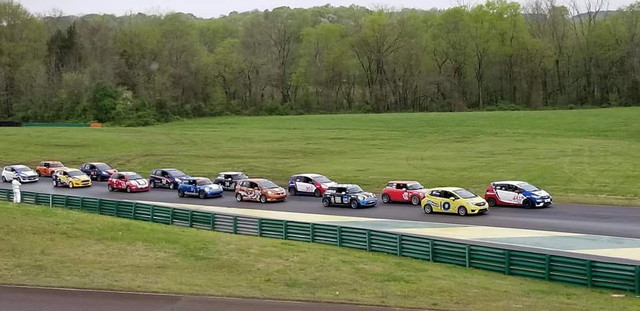
On Track with the SCCA
Road Race Levels / Series
SCCA Road Racing is divided into different levels and series to offer accessibility to best fit many resources and time commitments. These levels serve beginners up to seasoned pros. No matter what level you fit, SCCA has a place for your racing to call home.
Club Race Experience/Drivers School
For beginners and those budget conscious, SCCA road racing offers up Drivers School and Club Race Experience. Each of these levels can be done by people with no previous experience, and all you need is an SCCA legal racecar and required driver safety gear.
Club Race Experience is designed to give new competitors the opportunity to experience the SCCA. CRE is an introductory, low-risk wheel-to-wheel experience which includes coaching. It allows both licensed racers and total rookies to compete in lightly prepared racecars.
For those looking to compete at higher levels - including Regionals, Majors, and the Runoffs - SCCA Drivers Schools are a good place to start. Here SCCA instructors will guide you through the procedures and skills you will need to have to continue in SCCA road racing.
Vintage
For those drivers with older classic and historic racing cars, SCCA offers up Vintage Racing. These events are a little more gentlemanly than other Road Racing levels because many of the cars may be irreplaceable.
Regional/Divisional
SCCA Regional Road Racing works on the same rules that the upper levels do. Points series are usually spread through only a few states and tracks. Classes will include all of the Majors and Super Tour classes, but regionals also have the option of allowing more classes to fit the needs of local trends.
Conference Majors
Conference Major events is part of the U.S. Majors Tour hosted by SCCA Regions. These events include U.S. Majors Tour classes and depending on the event may also include Regional classes. These events tend to be a little more intense, and often drivers are here to match up with the highest competition.
Hoosier Super Tour
Hoosier Racing Tire SCCA Super Tour consists of 10 race weekends at 10 premier tracks across the United States. It is part of the U.S. Majors Tour with a Nationwide Points Championship and serves as a path to the SCCA National Championship Runoffs.
The Hoosier Super Tour schedule runs from January to July and offers a heightened experience for both competitors and race fans. Hoosier Super Tour events include live on-track action at SCCA.com, a “Super Tour Radio presented by Hoosier Racing Tire” program, dedicated staffing, and enhanced weekend social activities.
Runoffs
The SCCA's crown jewel event is the annual "Runoffs" and serves as a gathering for the top SCCA racers in the country to go head-to-head and prove who is best.
Pro Racing
SCCA has a long history of professional racing to go along with its amateur ranks. SCCA pro series started with the USRRC sports cars and along the way have included the ground-pounding Trans Am and 1,100-horsepower Can Am cars.
Road Race Classes
Cars and vehicles are classed in SCCA road racing according to type and modifications. You may find groups of Mazda Miatas racing against each other, or Porsches racing against Ferraris, or formula cars with wings grouped together. After all, it wouldn’t be fair to have a 3,500-lb nearly street legal car facing off against an 1,100-pound purpose built race car.
|
When the Majors and Super-tour level cars "age out" of their touring classes, they often find a second life as a regional-only "Improved touring" car. The Improved Touring or "IT" classes are allowed a few more modifications, but rule sets are tightly controlled for the budget and competition conscious. |
|
Super Touring® STL and STU STL is made up of small-displacement economy sedans and sports cars, and STU is made up of more performance-oriented cars. you will often see each of these class cars sporting wings and other extreme enhancements. |
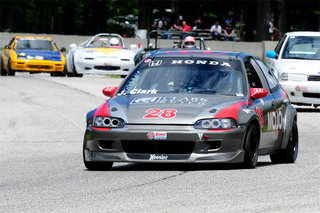
|
|
Grand Touring (GT1-GT3, GTL) The fastest of these classes is GT-1, and cars in this class can top 200 mph on the largest tracks the SCCA races on. The other end of the spectrum - the GT-3 and "GT-Lite" classes - have smaller displacement engines but still put down formidable lap times because of the allowances to the chassis and tires. |
|
Because of liberal rules on aerodynamics and lightweight motorcycle engines which power these cars, they are among the fastest cars on any given weekend at an SCCA road race. |
|
The faster of these classes including Formula Atlantic - the fastest class in SCCA Road Racing - allow wings and other aerodynamic features. On the lower end of the formula car speed spectrum, Formula F, Formula 500. and Formula Vee do not allow wings. |
|
Because of the reduced costs and equalized competition - spec classes are some of the most popular in the SCCA. "Spec Miata" and "Spec Racer Ford" often see 40 or more cars on the grid at events.
|
|
American Sedan is for American-origin coupes and sedans including Mustangs and Camaros. B-Spec is made up of FWD cars with moderate power to weight ratios. The cars are allowed limited modifications to the powertrain and many cars run a restrictor to equalize performance to around 100 wheel hp. Simple suspension modifications are allowed to enable racing appropriate dampers, better spring rates and adjustable ride heights. This is NOT a class for people who love to fabricate or spend endless hours retuning shocks. This is a driver’s class with a rules package tuned to promote reasonable costs, close dicing, and comradery. These cars are not intimidating for beginners to build or drive and they are generally known as the most affordable SCCA class. As the saying goes: “anyone can drive a fast car, only some people can drive a slow car fast”. The class is made up of naturally aspirated, small displacement economy cars. Current cars include but are not limited to the Mazda 2, Honda Fit, Ford Fiesta, Chevrolet Sonic, Kia Rio, Fiat 500 and Mini Cooper.
|
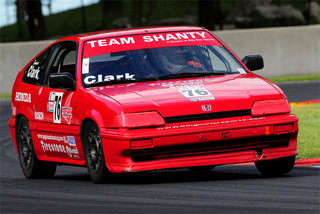 Regional Classes Regional ClassesOutside of the Hoosier Super Tour and SCCA Majors events - regional series are run to crown local champions. For regions running these events, they are allowed to run many classes that are not eligible for the higher series. These include the "Improved Touring" classes, Spec classes and classes for older cars frequently referred to with a "club" name like, "Club Formula Continental." |

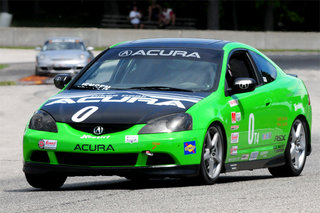 Touring Classes (T1-T4, and Improved Touring)
Touring Classes (T1-T4, and Improved Touring)

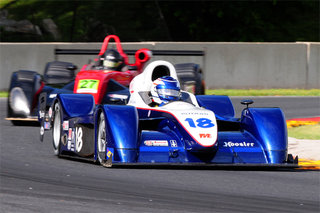
 Formula Cars (FA, FC, FE2, F5, FF, FV, FX)
Formula Cars (FA, FC, FE2, F5, FF, FV, FX) Spec Classes (SM, SRF3)
Spec Classes (SM, SRF3)
 Type Classes (AS, B-Spec)
Type Classes (AS, B-Spec)